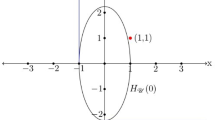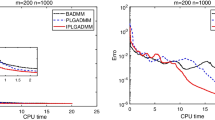Abstract
In the Conjugate-Gradient-Squared method, a sequence of residualsr k defined byr k=P 2k (A)r0 is computed. Coefficients of the polynomialsP k may be computed as a ratio of scalar products from the theory of formal orthogonal polynomials. When a scalar product in a denominator is zero or very affected by round-off errors, situations of breakdown or near-breakdown appear. Using floating point arithmetic on computers, such situations are detected with the use of ∈ i in some ordering relations like |x≤∈ i . The user has to choose the ∈ i himself and these choices condition entirely the efficient detection of breakdown or near-breakdown. The subject of this paper is to show how stochastic arithmetic eliminates the problem of the ∈ i with the estimation of the accuracy of some intermediate results.
Similar content being viewed by others
References
C. Brezinski,Padé-type Approximation and General Orthogonal Polynomials, ISNM vol. 50 (Birkhaüser, Basel, 1980).
C. Brezinski, M. Redivo-Zaglia and H. Sadok, Avoiding breakdown and near-breakdown in Lanczos type algorithms, Numer. Algorithms 1 (1991) 207–221.
C. Brezinski and H. Sadok, Lanczos type methods for solving systems of linear equations, Appl. Numer. Math., to appear.
C. Brezinski and M. Redivo-Zaglia, Treatment of near-breakdown in the CGS algorithm, Numer. Algorithms, to appear.
J.-M. Chesneaux, Study of the computing accuracy by using probabilistic approach,Contribution to Computer Arithmetic and Self Validating Numerical Methods, ed. C. Ulrich (J.C. Baltzer, 1990) pp. 19–30.
J.-M. Chesneaux, Stochastic arithmetic properties,Computational and Applied Mathematics, I-Algorithms and Theory, ed. C. Brezinski (North-Holland, 1992) pp. 81–91.
J.-M. Chesneaux, Descriptif d'utilisation du logiciel CADNA-F, MASI Report, n 92-31 (1992).
J.-M. Chesneaux and J. Vignes, Les fondements de l'arithmétique stochastique, C.R. Acad. Sci., Paris, série I, 315 (1992) 1435–1440.
J.-M. Chesneaux and J. Vignes, L'algorithme de Gauss en arithmétique stochastique, C.R. Acad. Sci., Paris, série II, 316 (1993) 171–176.
J.-M. Chesneaux, The equality relations in scientific computing, Numer. Algorithms 7 (1994) 129–143.
A. Draux,Polynomes Orthogonaux Formels. Applications, LNM 974 (Springer, Berlin, 1983).
C. Lanczos, An iteration method for the solution of the eigenvalue problem of linear differential and integral operators, J. Res. Natl. Bur. Stand. 45 (1950) 255–282.
C. Lanczos, Solution of systems of linear equations by minimized iterations, J. Res. Natl. Bur. Stand. 49 (1952) 33–53.
P. Sonneveld, CGS, a fast Lanczos-type solver for nonsymmetric linear systems, SIAM J. Sci. Stat. Comp. 10 (1989) 36–52.
J. Vignes, New methods for evaluating the validity of the results of mathematical computation, Math. Comp. Simul. 20 (1978) 221–249.
J. Vignes, Zéro mathématique et zéro informatique, La vie des sciences, Comptes Rendus, série générale, 4 (1987) 1–13.
J. Vignes, A stochastic arithmetic for reliable scientific computation, Math. Comp. Simul. 35 (1993) 233–261.
Author information
Authors and Affiliations
Rights and permissions
About this article
Cite this article
Chesneaux, JM., Matos, A.C. Breakdown and near-breakdown control in the CGS algorithm using stochastic arithmetic. Numer Algor 11, 99–116 (1996). https://doi.org/10.1007/BF02142491
Issue Date:
DOI: https://doi.org/10.1007/BF02142491




